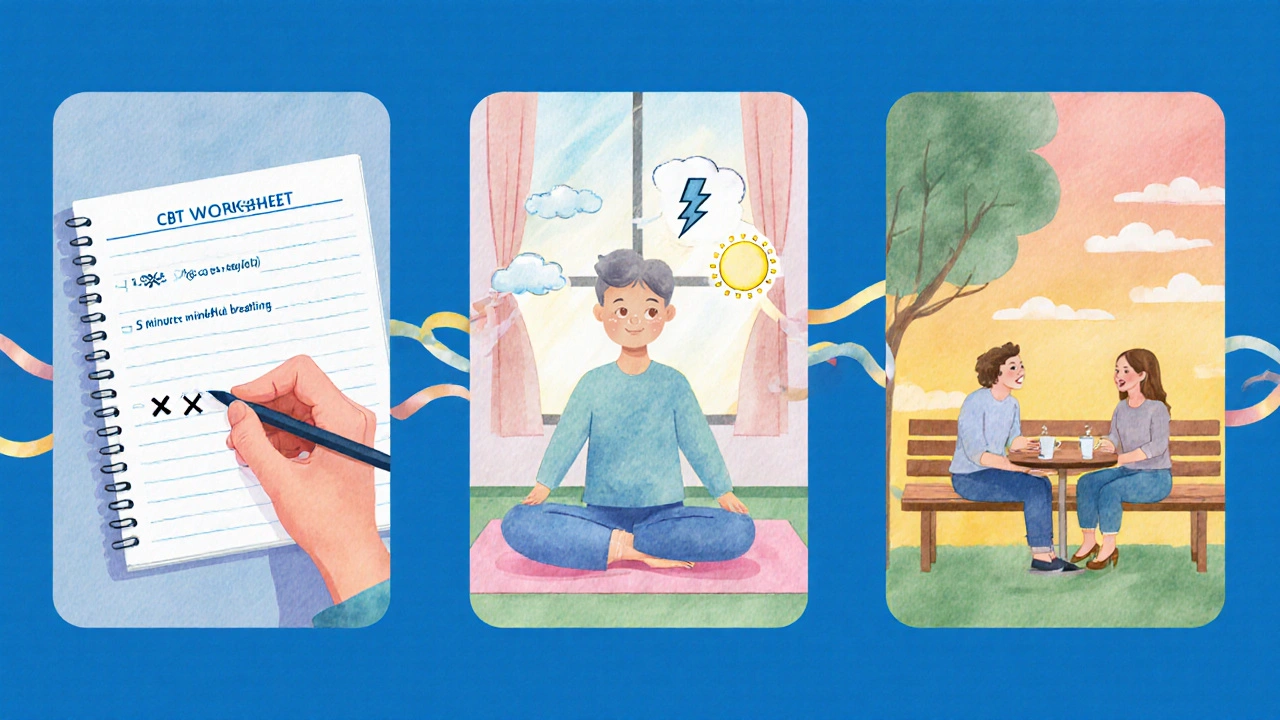Dating Fear Breakdown Tool
This tool helps you break down your dating fears step-by-step using proven techniques. Identify your specific fear, choose a method, and practice with guided exercises.
1. Name the Fear
Write down exactly what scares you. Be specific.
2. Challenge the Thought
Use CBT to find evidence for and against your fear.
3. Practice Mindfulness
Take 5-minute breathing exercises to calm your nervous system.
4. Gradual Exposure
Start with low-stakes social situations to build confidence.
5. Plan a Mini-Date
Set a clear, achievable goal for your next interaction.
6. Reflect & Record
Track your progress in a confidence journal.
| Technique | Core Principle | Typical Activity | Time to Notice Change | Best For |
|---|---|---|---|---|
| CBT | Identify and reframe negative thoughts. | Thought-record worksheet, weekly self-review. | 1-2 weeks with daily practice. | Those who over-think and self-criticize. |
| Mindfulness | Stay present, reduce physiological arousal. | 5-minute breathing, body-scan meditation. | Within a few days of consistent use. | People who feel panic symptoms (racing heart, sweaty palms). |
| Exposure Therapy | Gradual, repeated contact with feared situation. | Mini-dates, casual group outings, online chat practice. | 3-4 weeks for noticeable comfort. | Those who need real-world desensitization. |
Try This 5-Minute Breathing Exercise Now
Follow these steps to calm your nerves:
- Find a quiet place to sit comfortably.
- Close your eyes or soften your gaze.
- Breathe in slowly for 4 counts.
- Hold for 4 counts.
- Exhale slowly for 6 counts.
- Repeat for 5 minutes.
Feeling a knot in your stomach before a date? You’re not alone. Dating fear is a common hurdle that keeps many people stuck on the sidelines of romance. This guide breaks down why that fear shows up, how to tackle it step by step, and what everyday habits can turn nerves into confidence.
TL;DR - Quick Wins
- Identify the exact thought that scares you - write it down.
- Practice a 5‑minute mindfulness breathing exercise daily.
- Use a simple CBT worksheet to reframe negative self‑talk.
- Schedule low‑stakes “practice dates” with friends or acquaintances.
- Track progress in a confidence journal after each interaction.
overcoming fear in dating becomes easier when you blend mindset work with real‑world practice.
Why Dating Fear Happens
Most of us carry a bundle of social anxiety that spikes in romantic settings. The brain treats a first date like a performance audition, releasing cortisol and triggering the fight‑or‑flight alarm. Add low self‑esteem and past experiences of rejection, and the fear feels almost inevitable.
Step‑by‑Step Blueprint to Dismantle the Fear
- Name the Fear. Write the exact scenario that scares you - “I’ll say something stupid on the first date.” Naming it pulls it out of the subconscious.
- Challenge the Thought. Use a basic Cognitive Behavioral Therapy (CBT) worksheet: list the thought, evidence for it, evidence against it, and a balanced alternative. For example, replace “I’ll embarrass myself” with “I’ve had good conversations before; I can do it again.”
- Ground Yourself with Mindfulness. Spend 5 minutes each morning focusing on breath. Notice the inhale, the exhale, and let intrusive worries drift like clouds. This simple practice reduces cortisol levels over time.
- Gradual Exposure. Start with low‑stakes social interactions - a coffee chat with a coworker, a group meetup, or a short video call. Each success rewires the fear response.
- Plan a Mini‑Date. Set a clear, short goal: “Meet for 30 minutes at a park and talk about movies.” Keeping it time‑boxed lowers pressure.
- Reflect and Record. After each interaction, jot down what went well, what felt awkward, and one thing you’ll try next time. A confidence journal charts progress and reinforces growth.
Tools & Techniques You Can Use Today
The following table compares three proven strategies for tackling dating nerves. Pick the one that fits your style, or blend elements from each.
| Technique | Core Principle | Typical Activity | Time to Notice Change | Best For |
|---|---|---|---|---|
| CBT | Identify and reframe negative thoughts. | Thought‑record worksheet, weekly self‑review. | 1-2 weeks with daily practice. | Those who over‑think and self‑criticize. |
| Mindfulness | Stay present, reduce physiological arousal. | 5‑minute breathing, body‑scan meditation. | Within a few days of consistent use. | People who feel panic symptoms (racing heart, sweaty palms). |
| Exposure Therapy | Gradual, repeated contact with feared situation. | Mini‑dates, casual group outings, online chat practice. | 3-4 weeks for noticeable comfort. | Those who need real‑world desensitization. |

Real‑World Scenarios and How to Apply the Steps
Scenario 1: The First Date at a Café
Imagine you’re meeting someone from a dating app. Your mind jumps to “What if I’m boring?” Apply the CBT worksheet right before you leave: jot the fear, list proof you’ve had interesting talks before, and craft a balanced thought. Then, during the date, use a mindfulness cue - press your thumb to your index finger and breathe - whenever you notice your heart racing. After the coffee, write a quick note: “Shared a funny story, laughed together.”
Scenario 2: Moving from Text to Video Call
Online dating can feel safer, but a video call still triggers nerves. Treat it as a low‑stakes exposure. Schedule a 15‑minute call with a friend first, then with the match. Keep the conversation light - ask about favorite movies or weekend hobbies. Record your feelings afterward; you’ll see the anxiety shrink each time.
Common Pitfalls and How to Avoid Them
- Skipping the “Name the Fear” step. Without clarity, you’ll keep fighting vague anxiety.
- Relying on one technique only. Some people need both CBT and exposure to see lasting change.
- Setting unrealistic expectations. Expecting instant charisma creates pressure; celebrate small wins instead.
- Ignoring physical cues. Tight shoulders or shallow breathing amplify fear - use body‑scan mindfulness to release tension.
Building a Supportive Environment
Friends, family, or even a therapist can reinforce your progress. Share your goals with a trusted buddy who can serve as a practice partner. If anxiety feels overwhelming, consider a few sessions with a licensed counselor who specializes in rejection sensitivity. Professional guidance can accelerate the rewiring process.
Next Steps: From Theory to Action
Pick one of the three techniques from the table, write down the exact fear you want to tackle, and schedule a 30‑minute “practice date” this week. Use the journal template below to track your feelings before, during, and after the interaction.
- Fear statement (e.g., “I’ll be boring”).
- CBT reframe (e.g., “I’ve told funny stories before”).
- Mindful breathing count (1‑5).
- Outcome note - what went well?
- One tweak for next time.
Repeat this cycle for four weeks, and you’ll notice a tangible shift from dread to curiosity.
Frequently Asked Questions
How long does it take to stop feeling nervous before a date?
Most people see a reduction in anxiety after 2-4 weeks of daily mindfulness and weekly exposure practice. Consistency is key; occasional setbacks are normal.
Can I use these strategies if I’m on a dating app?
Absolutely. Start by practicing low‑stakes chats with matches, then transition to video calls or in‑person meetups. The same CBT and mindfulness tools apply.
What if I’ve tried mindfulness and it didn’t help?
Combine mindfulness with CBT or exposure. Sometimes layering techniques creates the breakthrough. If anxiety remains high, consider a brief course with a therapist.
Is it okay to tell a date I’m nervous?
A short, honest line can humanize you and defuse tension. For example, “I’m a little nervous because I really want this to go well.” Most people appreciate sincerity.
How do I handle rejection without losing confidence?
Treat rejection as data, not a verdict. Write down what you learned, thank the other person for their honesty, and schedule your next practice date within 48 hours.


Written by Eldridge Fairweather
View all posts by: Eldridge Fairweather